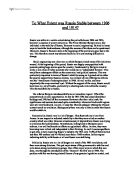The idea of a legislative Duma gave the politically active part of the Russian population something to celebrate, however before the first one, April-June 1906, met, the Fundamental Laws were published and the mood of the Duma was bitter. It was dominated by 182 Kadets, who met within the Duma and displayed their anger, along with the rest of the deputies. This resulted in the Vyborg Appeal, where 200 Kadet and Labourist deputies drew up an appeal to the public for passive disobedience. However, this turned to violence. Whether this violence was political could be argued, however, it is implied to be so, thus, once more, demonstrating the instability of politics in Russia.
The next Duma, February-June 1907, was filled by Social Democrats (SD’s) and SR’s, the same SR’s who had boycotted the first Duma. This was known as “the Duma of the people’s wrath.” Indeed, it was filled with anti-Tsarist deputies, who directed their strong views by attacking the way that the imperial army was organised and deployed, thus causing the SR’s and SD’s to be accused of subversion and the Duma to be dissolved. Once again, the instability within the Duma suggests that Russia wasn’t generally politically stable, due to the fact that, so far, a Duma couldn’t last more than a few months without Nicholas II dissolving it because he was upset at the way the deputies within the Duma, elected by the public, tried to indirectly point out the fault of his leadership, such as the attack on the way the army was organised. This shows, yet again, the political instability within Russia in 1907.
However, Stolypin found a way to ‘get rid of’ the political unrest by rigging the election for the next Duma, November 1907-June 1912, producing a more co-operative assembly of Octobrists and Rightists, 154 and 147, respectively. This suggests that at least Nicholas’ ministers, if not he, himself, could see the political instability, and tried to do something about it. The heavy dominance of pro-Tsarist deputies allowed the passing of 2571 bills. The next Duma, November 1912-August 1914, was also heavily right-wing, allowing this positive work to continue, suggesting that the third Duma was the one to change the political instability to political stability, however the fourth Duma voiced its criticisms of the Tsar’s government, once more demonstrating signs of political instability, albeit less than it had been known to be previously. The end of the fourth Duma was the Great War, and the Duma supported the idea of dissolving itself for a period to help the national war effort, which contrasts with the view that the Duma was a vent for political instability, raising the question of: did the fourth Duma actually mean to be supportive of the Tsar, or was it just support for the idea that Russia could possibly make a positive contribution towards winning a war?
It must be considered that, following the rigging of the election for the third Duma, the SR’s and SD’s were not very common in the Duma. This could be explained by the fact that the SD’s were mostly in exile and the SR’s had disappeared underground. Underground opposition is much more of a threat; it could spring up at any time, causing a rather worrying level of political instability. Should Russia prepare for a revolution attempt, or should she prepare for the future? This tough decision links back to the third Duma having been rigged- only letting in 19 Bolsheviks, no Mensheviks and no SR’s. Stolypin’s efforts to pass his land reforms caused the SR’s to head underground, where they could concentrate on any plans they might have to overthrow the government.
Another consideration should be the number of strikes recorded between 1905 and 1914. The startling figure of 13995 for 1905 suggests the tension exhibited by the ‘nearly’ revolution, but this number drops dramatically to 892 in 1908, which implies that both social and political unrest were not as prevalent. However, in the years of the fourth Duma, the figures raise to 2032 in 1912, 2404 in 1913 and 3574 in 1914, mirroring the way things were working within the Duma; starting badly, followed by a relative peace, but ending with a level of political instability, which did seem to be a great deal less than in 1906.
The years 1905-1914 could be considered as a power struggle, with Nicholas II trying to retain his autocratic rights, but the public wanted a more democratic approach within Russia. The fact that Nicholas never completely got rid of the Duma’s suggests that he knew he had to give away some of that power of his in order to prevent a political uprising. The number of strikes, political and social, mirrored how the Duma was operating: poorly at first, then better, but becoming worse towards the end. Stolypin saw the political instability within the Duma and tried to change this by rigging elections so that the third Duma was pro-Tsarist, but in doing so, he drove the opposition underground and made matters worse by creating this ‘coiled spring’ that could easily have spoilt the new-found stability, but also, the rest of the time, the strains shown by the public, the Duma deputies and Nicholas’ power battle suggest that Russia was politically unstable, for much of the duration of the period 1905-1914, with an almost peace for the duration of the third Duma. However, the shock of the 1917 February Revolution shows politics wasn’t the main problem within Russia.







